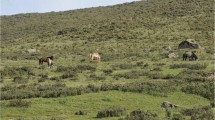Abstract
Certain exotic plants may increase risk of nest predation, and, in this way, may act as ecological traps. We hypothesized that the greater vulnerability to predation was a consequence of either (1) reduced nest height due to architectural differences among plant species or (2) seasonal changes in the distribution of nests among forest strata. To test this, we examined temporal variation in nest survival of 888 nests of Northern Cardinal (Cardinalis cardinalis) in native substrates and two exotic shrubs (Lonicera maackii and Rosa multiflora) in Ohio, USA, 2001–2006. We evaluated evidence for an ecological trap by monitoring the annual reproductive productivity of 245 breeding pairs of cardinals. Only nests in Rosa experienced relatively constant survival rates across the season, whereas probability of survival increased over the season for nests in other substrates. Interestingly, the relative vulnerability of nests in different substrates varied across the season. Most strikingly, nests in Lonicera in early spring showed the lowest survival rates but exceeded survival rates of nests in native substrates late in the season. Nest height failed to explain seasonal changes in nest survival, as only nests in native plants significantly increased in height as the season progressed. Rather, predation risk seemed to be a function of the proportion of nests within each substrate, as illustrated by the decreased predation in Lonicera as the relative proportion of nests in native substrates increased. The patterns of temporal variation in predation risk that we detected show that impacts of Lonicera are not a function of plant architecture alone and may be related to leaf phenology, changes in nest density, nest site location, and/or nest synchrony. Examination of the reproductive productivity of cardinals showed that pairs that made their first nest attempt in Lonicera fledged 20% fewer cardinal young than birds that began the season using other substrates. Thus, we suggest that exotic plants may represent an ephemeral ecological trap for certain nesting birds, where negative effects persist only during certain periods.



Similar content being viewed by others
References
Borgmann KL, Rodewald AD (2004) Nest predation in an urbanizing landscape: the role of exotic shrubs. Ecol Appl 14:1757–1765. doi:10.1890/03-5129
Borgmann KL, Rodewald AD (2005) Forest restoration in urbanizing landscapes: interactions between land uses and an exotic shrub. Restor Ecol 13:334–340. doi:10.1111/j.1526-100X.2005.00042.x
Burnham KP, Anderson DR (1998) Model selection and inference. A practical information-theoretic approach, 1st edn. Springer Inc, New York
Dinsmore SJ, White GC, Knopf FL (2002) Advanced techniques for modeling avian nest survival. Ecology 83:3476–3488
Filliater TS, Breitwich R, Nealen PM (1994) Predation on Northern Cardinal nests: does choice of nest site matter? Condor 96:761–768. doi:10.2307/1369479
Leston LFV, Rodewald AD (2006) Are urban forests ecological traps for understory birds? An examination using Northern Cardinals. Biol Conserv 131:566–574. doi:10.1016/j.biocon.2006.03.003
Lloyd JD, Martin TE (2005) Reproductive success of Chestnut-collared longspurs in native and exotic grassland. Condor 107:363–374. doi:10.1650/7701
Mahony NA, Krannitz PG, Martin K (2006) Seasonal fecundity of sagebrush brewer’s sparrow (Spizella breweri breweri) at the northern edge of its breeding range. Auk 123:512–523. doi:10.1642/0004-8038(2006)123[512:SFOSBS]2.0.CO;2
Martin TE (1993a) Nest predation among vegetation layers and habitat types. Revising the dogmas. Am Midl Nat 141:897–913
Martin TE (1993b) Nest predation and nest sites: new perspectives on old patterns. Bioscience 43:523–533. doi:10.2307/1311947
Martin TE, Roper JJ (1988) Nest predation and nest-site selection of a western population of the hermit thrush. Condor 90:51–57. doi:10.2307/1368432
Niemuth ND, Boyce MS (1995) Spatial and temporal patterns of predation of simulated sage grouse nests at high and low densities: an experimental study. Can J Zool 73:819–825. doi:10.1139/z95-096
Ortega YK, McKelvey KS, Six DL (2006) Invasion of an exotic forb impacts reproductive success and site fidelity of a migratory songbird. Oecologia 149:340–351. doi:10.1007/s00442-006-0438-8
Remes V (2003) Effects of exotic habitat on nesting success, territory, density, and settlement patterns in the blackcap (Sylvia atricapilla). Conserv Biol 17:1127–1133. doi:10.1046/j.1523-1739.2003.01611.x
Rodewald AD (2009) Evaluating factors that guide avian community response to urbanization. Stud Avian Biol (in press)
Rodewald AD, Shustack DP (2008) Consumer resource matching in urbanizing landscapes: are synathropic species over-matching? Ecology 89:515–521. doi:10.1890/07-0358.1
Scheiman DM, Bollinger EK, Johnson DH (2003) Effects of leafy spurge infestation on grassland birds. J Wildl Manage 67:115–121. doi:10.2307/3803067
Schmidt KA, Whelan CJ (1999) Effects of exotic Lonicera and Rhamnus on songbird nest predation. Conserv Biol 13:1502–1506. doi:10.1046/j.1523-1739.1999.99050.x
Shaffer TL (2004) A unified approach to analyzing nest success. Auk 121:526–540. doi:10.1642/0004-8038(2004)121[0526:AUATAN]2.0.CO;2
Shustack DP, Rodewald AD, Waite TA (2009) Springtime in the city: exotic shrubs promote earlier green-up of urban forests. Biol Invasions. doi:10.1007/s10530-008-9343-x
Vitousek PM (1990) Biological invasions and ecosystem processes: towards an integration of population biology and ecosystem studies. Oikos 57:7–13. doi:10.2307/3565731
Weatherhead PJ, Sommerer SJ (2001) Breeding synchrony and nest predation in red-winged blackbirds. Ecology 82:1632–1641
Westneat DF (1992) Nesting synchrony by female red-winged blackbirds–effects on predation and breeding success. Ecology 73:2284–2294. doi:10.2307/1941475
Zavaleta ES, Hobbs RJ, Mooney HA (2001) Viewing invasive species removal in a whole-ecosystem context. Trends Ecol Evol 16:454–459. doi:10.1016/S0169-5347(01)02194-2
Acknowledgments
Funding was provided by National Science Foundation (DEB-0340879 and DEB-0639429 to ADR), Ohio Division of Wildlife, Ohio Agricultural Research and Development Center, and The Ohio State University Swank Program in Rural-Urban Policy. We are grateful to M. H. Bakermans, K. L. Borgmann, F. V. L Leston, J. R. Smith-Castro, M. Carll, J. Fullerton, A. Gilmore, B. Graves, J. Gray, S. Hazzard, M. Howie, M. Kanode, J. Kim, S. Landes, T. Magarian, A. Maruster, J. McConnell, D. Miller, J. Morcillo-Blanco, M. Nelson, E. Norris, C. O’Dell. M. Santiago, and A. Vitz for dedicated efforts in field and lab. Thanks to Franklin County Metro Parks, Columbus Recreation and Parks, Gahanna Parks and Recreation, and private landowners for access to sites. We appreciate the input from D. Simberloff and two anonymous reviewers, whose collective suggestions improved our manuscript.
Author information
Authors and Affiliations
Corresponding author
Rights and permissions
About this article
Cite this article
Rodewald, A.D., Shustack, D.P. & Hitchcock, L.E. Exotic shrubs as ephemeral ecological traps for nesting birds. Biol Invasions 12, 33–39 (2010). https://doi.org/10.1007/s10530-009-9426-3
Received:
Accepted:
Published:
Issue Date:
DOI: https://doi.org/10.1007/s10530-009-9426-3




